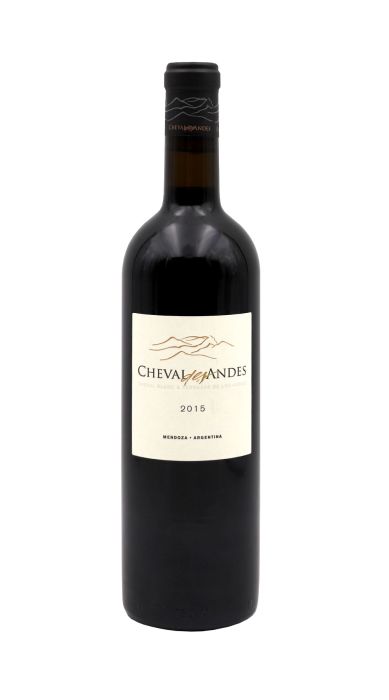Need Help Finding the right wine?
Your personal wine consultant will assist you with buying, managing your collection, investing in wine, entertaining and more.
NYC, Long Island and The Hamptons Receive Free Delivery on Orders $300+
Checkout using your account
Checkout as a new customer
Creating an account has many benefits:

2015 Cheval des Andes
98 JS
James Suckling | 98 JS
| Type of Wine |
Argentina Red
: If there were ever a single word that could perfectly describe fine Argentinian wines, it would be "purity." Red wine lovers could easily become spoiled for choice when that choice involves varietals such as Malbec or Tempranillo. With a complete dedication to a given grape, each bottle tells a compelling story, so have a seat and listen. |
|---|---|
| Varietal | Bordeaux Blend |
| Country |
Argentina
: Argentina’s landscape is marked by its extreme geographical features; from the soaring, rocky peaks of the Andes’ and coastal Patagonia to the arid soils of Mendoza to the fertile Pampas lowlands in the east. Its vast array of landscapes, climate and geography, along with truly accomplished and passionate vintners has helped galvanize its name among the very best wine producing regions in the world. Its adopted grape variety, Malbec, is now responsible for some of Argentina’s most famous wines and has helped to elevate its ever growing wine industry. Vines have been cultivated in Argentina since the 1500’s; however it was not until the 1990s when its true potential was recognized, drawing the attention of accomplished winemakers to its diverse soils. After making a name for himself in California, Paul Hobbs’ foresight and vision led him to cultivate Argentinian soil. More than merely an exploration of terroirs, Vina Cobos was created to showcase what is possible with one of the world’s most compelling noble varietals, Malbec, in a land where its soul soars above all others. Its inaugural vintage marked a milestone, but two decades later, Cobos made history when the 2011 vintage Cobos Malbec became the country’s first professionally rated 100-point wine, defying existing standards and firmly positioning Malbec and Argentina on the international wine scene. This accomplishment became the blueprint that many others would follow. Today, the high altitude deserts have given rise to a high quality wine industry. The region of Mendoza has gained global recognition for its quality production of Malbec, the ubiquitous and most compelling varietal cultivated in Argentina. Three quarters of Argentinian wine production takes place in Mendoza with Mendoza Malbec accounting for 85% of all Malbec produced in the country. In addition to its flagship varietal, Argentina also boasts significant plantings of Cabernet Sauvignon, Chardonnay, Bonarda and its signature, aromatic white varietal, Torrontes. In more recent years, vineyards have been planted to Cabernet Franc, Pinot Noir and Tempranillo. Despite its location near the equator, extreme temperatures are muted by the high altitudes and cold mountain air. Argentina is home to a world-topping vineyard and currently the highest elevation being cultivated at a whopping 9,900 feet above sea level. The Andes’ play a significant role in its climate as it casts a rain shadow over its foothills, allowing very little rain fall and a slow growing season. This slow ripening period leads to concentrated fruit, balanced sugars and acidity in the grapes. From the southern reaches of Patagonia to the northern regions of Salta and Catamarca, the land plays a vital role in the winegrowing and making practices here. Its terroir is well suited to not only Malbec, but to the many varieties in the country’s portfolio. Argentina boasts an impressive 223,500 hectares under vine with an annual wine output of 10.8 million hectoliters. The country has recently edged Australia’s production and now sits at fifth among all leading producers in the world. Argentina has become one of the most important wine producing countries on Earth, the largest region in South America and one of the principal faces of New World winemaking. Argentina is a remarkable land; one which truly tells its story through the wine itself. |
| Region |
Argentina
: The largest wine producer in South America also holds its place as one of the most prominent winemaking regions in the world. Argentinian vineyards are mostly situated in the shadow of the Andes, on high altitudes but comfortably sheltered from rain, relying on meltwater for their irrigation. This fortunate terroir allows for a slow, steady ripening process which unmistakably provides wines that are consistently intense, vibrant, balanced between the sweetness and acidity with a bright, plump, fruity bouquet. The first Argentinian wine that comes to mind is Malbec. Though the grape is adopted from Bordeaux, it's Argentina that produces some of the most luscious, richest, highest-quality Malbec wines today. Mostly produced in Mendoza, these gems brilliantly showcase the mighty but beautiful spirit of the Andes and the life that's being lead there. Home to Chardonnay, Cabernet Sauvignon and Bonarda varieties among many others, this region produces some of the finest bottles in the world. Potent yet layered, sweet but tart and packed with floral, black currant and spice flavors, these wines are not the ones to miss out on. If you're on the lookout for stunning reds, or delicate, floral, mouthwatering white wines, Argentina should make the top of your list. |
| Producer | C.Andes |
|---|
Need Help Finding the right wine?
Your personal wine consultant will assist you with buying, managing your collection, investing in wine, entertaining and more.